
Austin, TX 78701
tourdesk@visitaustin.org
(512) 478-0098
www.visitaustin.org
Everything I Saw at Fantastic Fest: The Most Far Out Film Festival in Texas
by Hunter Lanier
All year long, the Alamo Drafthouse on South Lamar–known in some circles as the Bong Joon Ho Cinema–serves as a bastion of film buffitude. But at the end of every September, the Austin theater is possessed by the benevolent spirit of Fantastic Fest, one of the biggest genre film festivals in the world. If SXSW is the Luke Skywalker of Austin film festivals, Fantastic Fest is the Han Solo–not the biggest face on the poster, but the one everybody dreams about.
As experts on all things Lone Star State, we at Tour Texas sent our most intrepid reporter–our one-man Woodward and Bernstein–to cover the festival and see what all hubbub was about. Unfortunately, he disappeared somewhere in La Grange, so I, Hunter Lanier, was sent instead.
A Cinematic Party House

It doesn’t take long upon arriving at the Alamo Drafthouse before you realize something is different. Maybe it’s the massive crowd mingling outside, pouring into the street and exchanging hot takes like hot potatoes, or maybe it’s the dragon giving you the evil-eye from the roof, but it quickly becomes clear that Fantastic Fest isn’t just about the movies. It’s almost like a renaissance festival in reverse, where everyone gets to shed their costume of normalcy–take off their black-rim glasses–and unravel their freak flag. As wild as the festival may look from the outside, the atmosphere is relaxed enough that I saw Patton Oswalt (comedian and actor), C. Robert Cargill (co-writer of Doctor Strange), and Chris Stuckmann (YouTube film critic and director) all amongst the crowd in lively conversations with fans.
Inside the Alamo is The Highball, a karaoke bar that had nary a moment to rest during the festival. Every time I walked in there to escape the humidity–a trash can-shaped fan was outside which did little but blow hot air and slap the person next to you with your press badge–there was some new energy bouncing off the walls. Sometimes, it was something as simple as a dance party or a podcast. At other times, it was Tiffany Haddish singing Tina Turner songs, which I unfortunately didn’t have my camera for. Yes, I know my phone is also a camera, but when you have a camera camera, you stop thinking of your phone as a camera. Look, our best guy disappeared in La Grange!

The Fantastic Fest party doesn’t end at The Highball, either. Over at the South Austin Gym, a boxing ring hosted the Fantastic Debates, which either devolved or evolved–depending on one’s taste–into a wrestling match between two knights in smudgy armor.
Fantastic Fest Movie Review Round-Up
Partying aside, let’s not forget Fantastic Fest is a film festival first and foremost. While I didn’t see as many movies as the alliteration in that last sentence might suggest, I did see five and a half yet-to-be-released pictures of the major-motion variety. Blue Bell for breakfast may be taboo, so, instead, here’s the early scoop on some of the fall’s biggest upcoming releases.
The Piano Accident
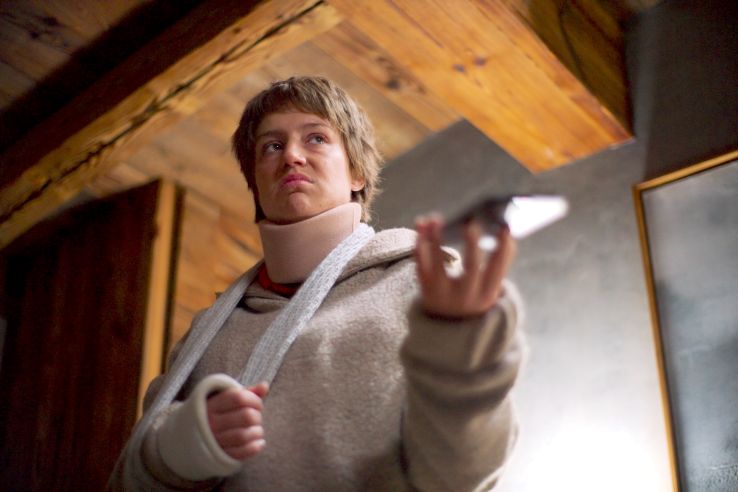
The Piano Accident is another high-concept, absurdist comedy from French writer/director/composer, Quentin Depeiux. It relies in equal parts on dark comedy and lowbrow silliness, then puts at the center of the Tootsie Pop a critical look at internet celebrity.
Its main character, Magalie (played by Adèle Exarchopoulos, who some may remember from Blue is the Warmest Color), is like five SNL characters smushed together. She has a goofy bowl cut, adult braces, a sling, a neck brace, and dresses like a grandma waiting in line to buy stamps at the post office. All of her obnoxious mannerisms are cranked up as loud as they can go–complete with a snicker that would make Beavis & Butt-Head blush.
How does such a person become a world-wide celebrity, you ask? She films herself getting injured in a variety of creative ways. The catch is that she has a rare disease that prevents her from feeling pain. As the film goes on, we start to wonder if she can feel anything at all. It’s here the film reveals its central question: to what extent is the internet desensitizing us?
3 out of 4 Lone Stars
Release Date: Unknown
Sirat
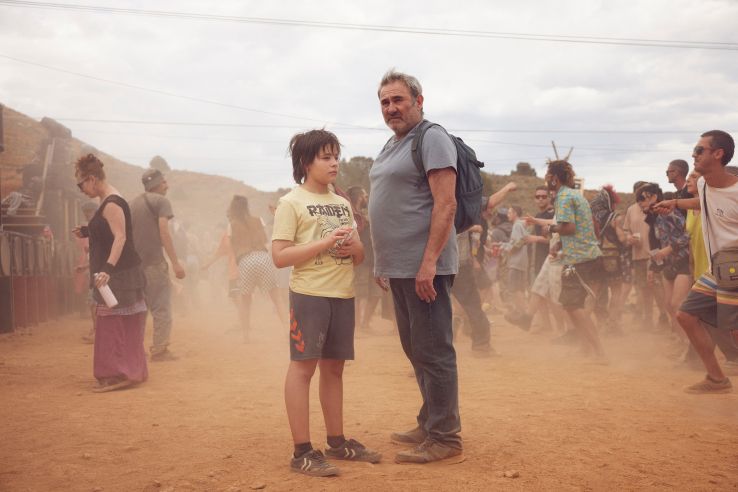
Sirat is the best movie I saw at Fantastic Fest. It’s no wonder Spain has chosen it as their submission to the Oscars’ best international feature category. While it brings to mind so many disparate influences, the ones that rise to the surface are The Wages of Fear and Sorcerer. I was not expecting a Spanish film to come out of nowhere to be the next in that royal bloodline, but here it is. The film isn’t a remake of The Wages of Fear like Sorcerer was, but it has that same concept of driving flimsy vehicles from one place to another on unforgiving terrain. And tension is, to put it mildly, taut.
The reason for the voyage is simple: a man and his son are looking for the third member of their family: the daughter. The only lead they have is that she’s gone to a rave in the desert. When we first meet them, they’re at such a rave, which is soon dispersed by an ambiguous military force. Although the daughter isn’t there, they find out some members of the rave are on their way to another one, so the father and son follow them. As the father and son tag along with this caravan of career ravers–with their clunky RVs, tattoos, piercings, and missing limbs, they’re almost like carnies-–they begin to form a bond. This is especially true for the son, who finds their freewheeling lifestyle quite appealing.
Of course, I won’t spoil where it goes from there, but I will say the film has several surprises, and the director, Oliver Laxe, is really good about hitting you with them on the offbeat. When you’ve seen enough movies, you start to subconsciously get the rhythm of tension down. Sirat shocks you by getting you in-between the beats. It knows when you think it’s going to do something, then it double-outthinks you and hits you with it faster or takes a half-step longer to catch you off guard. Great boxers do this with the timing of their punches, establishing a rhythm to lure their opponent into it, then intentionally disrupting it. In that same way, Sirat does not end as the movie it starts out as.
While the film gets much of its tension from Sorcerer-esque vehicular peril, that’s mostly where the comparisons end. Because the film has a lot of heart, especially between the father and his son. They don’t have much dialogue between each other, but that’s a sign of their closeness–not much needs to be said when you know someone deeply. And those aren’t just pretty words–you feel that warmth between the two in their performances.
There’s also something deeply spiritual about the movie. Its first impression is with the rave in the middle of the desert. It’s such a stark, eerie image. You have an endless, harsh landscape of orange rock and sand, then here in the middle of it, hundreds of people have set up speakers and are dancing to thumping electronic music. And they’re dancing in this very loose, puppet-like way–notabably, almost entirely as individuals; not together, as couples. There’s an alienness to the whole thing; it feels like you’re being welcomed into an underworld with some strange ritual. Combined with the objective of the father and son trying to find their daughter/sister, this all gives the story a mythological patina, like Orpheus descending into the underworld to find Eurydice.
When introducing Sirat, the programmer brought up the fact that it won Best Soundtrack when it premiered at the Cannes Film Festival earlier this year. It makes sense, given there’s almost a physicality to the sound design. It’s as if you can feel the sound of wood rubbing against wood or metal clashing against rock.
3 ½ out of 4 Lone Stars
Release Date: November 14, 2025
Shelby Oaks
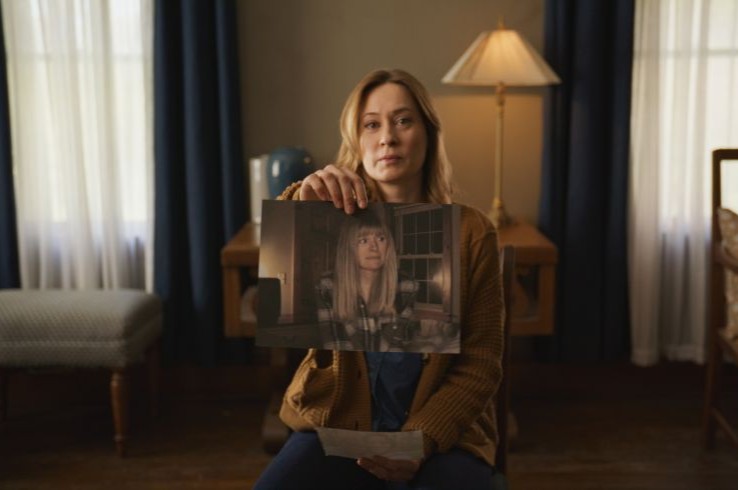
Shelby Oaks, written and directed by Chris Stuckmann, begins as a documentary–or shockumentary, if you will–telling us all about Riley, the leader of a YouTube channel called Paranormal Paranoids who went missing after a strange video. In the documentary, Riley’s sister, Mia, is interviewed and we find out she hasn’t given up on finding Riley. The documentary abruptly ends and we’re thrust into the fictional realm of the movie as we follow Mia’s quest to find Riley, which takes her to creepy places that go bump in the night.
Starting the film out with a fake documentary, I can get behind. Think of it as a more engaging version of the Star Wars crawl. Instead of just throwing paragraphs of exposition at us, we watch a little “last time on Shelby Oaks” to catch us up with what’s happening. It’s not the sublest or most skillful way to slide us context, but it’s something. However, after that, the film really struggles with momentum and pacing. People always bring up pacing, but what does it really mean? It means the movie just doesn’t flow–the story and character beats don’t compliment each other in a linear way–they don’t build. The film feels very choppy, like it’s a series of big chunks of “this happens, then this happens.” There’s not enough connective tissue in the form of characterization or aesthetics. In fact, when the movie ended, I thought the third act was just starting. I thought to myself, “okay–they got all the setup out of the way, now the other shoe will drop.” Alas, we were all out of shoes.
If this was a different kind of movie, the momentum wouldn’t really be a problem, because the emphasis would be on dialogue, characters, atmosphere, and more in-the-moment points of interest. Shelby Oaks has none of that going for it. Shelby Oaks is a plot-driven movie, but the plot never takes you anywhere. It throws you in the car, then drives you around and around the parking lot of a horror movie strip mall of chain-store tropes. There is a certain direction the plot takes at one point that I thought could be interesting, but afterward, the film hits the brakes and skids into the next strip mall.
Speaking of tropes, the film is abrasively generic. Stuckmann was interviewed before the movie, talking about how he pitched it to a producer at Fantastic Fest in 2019. After watching the movie, I can’t imagine what the pitch was. The movie is mostly just a creepy cabin, creepy woods, a creepy prison, and creepy old ladies–you’ve seen all this before. And by being so generic, it prevents the film from ever really being scary, because to be scared, you have to be put off balance first. You have to feel uneasy. In Shelby Oaks, you always feel like you’re someplace familiar.
1 ½ out of 4 Lone Stars
Release Date: October 24th, 2025
Black Phone 2
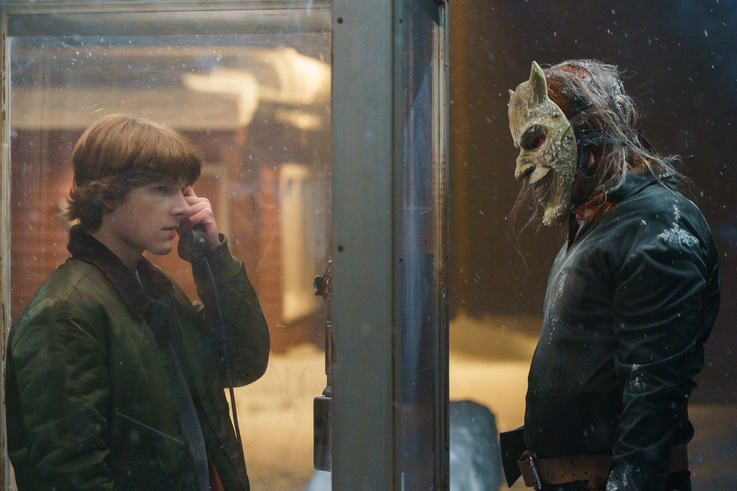
Black Phone 2 really surprised me. It caught me off guard just how much fun I had. What makes it so good is that it’s a totally different movie than the first film, The Black Phone. The first film was fairly pedestrian and safe, though it did have more believable emotions than a lot of these horror movies that try to shoehorn in the touchy-feelies with the creepy-crawlies.
Where the sequel steers the ship in the right direction–and makes it, in many ways, the perfect sequel–is that it doubles-down on everything that works about the first movie and tosses out everything that didn’t work. Tonally, Black Phone 2 is on a different planet than the first movie. The first film felt fairly grounded: an abduction drama tinted with supernatural elements, but it mostly felt like something that could really happen. The sequel, on the other hand, is a big, wild supernatural slasher flick. The A Nightmare on Elm Street comparisons will be flying for this movie, and after the film was over, Scott Derrickson (director and co-writer with C. Robert Cargill) fully embraced those comparisons in a post-film Q&A. And it’s here where Ethan Hawke’s “The Grabber” works much better this time. Yes, he still has the dumb mask and the clownish voice from the first film, but they now exist in this more extravagant tonal context where they feel much more at home.
Part of the reason this wild shift in tone works is that I think Scott Derrickson’s sensibilities lean more toward this campy, ‘80s style of horror than the first film’s realistic horror. There are set pieces in this movie that are truly crazy and memorable. Also worth mentioning is how much of this movie is shot with an 8mm camera, and how great it looks on screen. Derrickson uses it for the dream sequences, which are plentiful, and the softness of the 8mm footage really adds to the trippy mood of the movie. There’s one moment in the film when The Grabber fades into the darkness. On a sharp digital camera, it would look like he’s overwhelmed by inky blacks, but with the 8mm footage, it’s almost like he dissipates into thin air. There’s another great moment when a dream sequence ends with the 8mm film strip burning up.
Now, the movie isn’t perfect. What bothered me most were some of the ancillary characters, particularly this character named Mustang, who’s a young woman that works at a Youth Camp. She wears perfectly tailored cowgirl outfits and everything she says is written to be the coolest thing you’ve ever heard…and it never is.
3 out of 4 Lone Stars
Release Date: October 17, 2025
If I Had Legs I’d Kick You
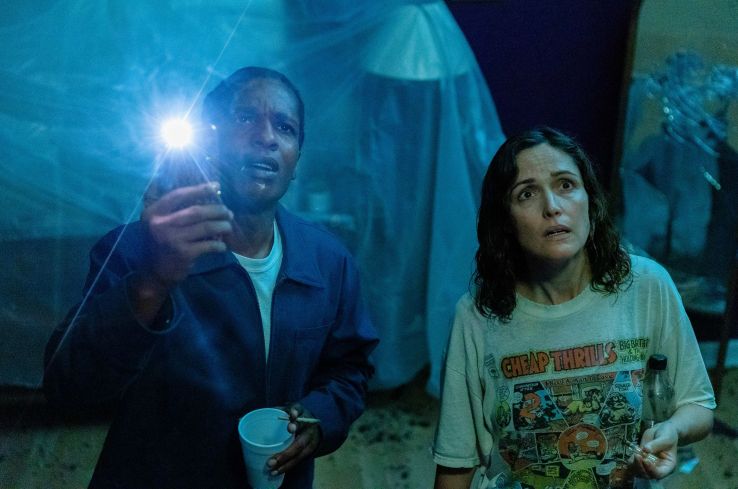
If I Had Legs I’d Kick You, written and directed by Mary Bronstein, is an extremely confident movie, because it has a very clear goal. It wants to put in you a very particular headspace, then hold and squeeze you there. It wants to suffocate you in the compounding, day-to-day death-of-a-thousand-cuts that is the life of Linda, played by Rose Byrne. Linda’s daughter has some kind of eating disorder where she’s required to wear a feeding tube in order to get her nutrients–and even beyond that, is an absurdly high-maintenance child. Their apartment’s roof has also caved in under immense water pressure and ruined everything, forcing them to temporarily live in a crummy hotel. Linda works as a therapist, which means she spends all day with extremely sad and sometimes disturbed people, then finds the closest thing to a respite in sessions with her own therapist (played by Conan O’Brien, in a rare film appearance). Her husband is away for work, leaving Linda to take care of their daughter, the reconstruction of their home, and to manage her own sanity.
If it’s not clear yet, Linda goes through life like she’s juggling chainsaws, while a giggling clown stands in the corner and tosses her a new one when she gets too comfortable. Her entire day is filled with screaming children, crying adults, honking cars, beeping medical devices, and each seems to be a different wall closing in on her. And you feel all of this. Instead of the film telling you the story, it pulls you into the story with its frustrating sound design. As this snowball of stress rolls furiously downhill, it picks you up and takes you with it.
There’s also something to be said about the character of Linda. Bronstein doesn’t write Linda to be a proxy, to be relatable, or to be sympathetic. It’s quite clear that for as much as it seems that life has it out for her, she’s not doing herself any favors. A lesser writer would shy away from the character’s less copacetic side, but Bronstein leans into it. If you don’t know how to feel about Linda by the end of the film, that’s how you’re supposed to feel.
Lastly, I found the movie to say something interesting about the nature of recursive relationships. Linda is a therapist who sees a therapist–the behavior that causes her to think less of her patients is the exact behavior she exhibits to her own therapist. When the film ends, it had me wondering how important these recursive relationships actually are, beyond the therapy room.
3 ½ out of 4 Lone Stars
Release Date: October 10, 2025
Silent Night, Deadly Night
This is a remake of the 1984 horror film by the same name. It was so bad, I walked out after 30 minutes.
No Lone Stars Whatsoever
Release Date: December 12, 2025
Get Ready for Fantastic Fest 2026

We know, we know. You want to go to Fantastic Fest, but you have to pay for a hotel and your budget is tight. One of the ways around this is to stay just outside of town where it’s much more affordable, rather than in the city. Since Austin is smaller than Dallas or Houston, it’s much easier to get in and out. Plus, once you’re at the Alamo Drafthouse, there are plenty of restaurants within walking distance, so you can park there in the morning, then spend all day watching movies, eating, and hanging out.
As for nearby places to stay, Tour Texas has all the latest information on nearby towns like Round Rock, Cedar Park, Buda, Dripping Springs, and more. Not only are these great places to stay, but they have plenty of things to do and attractions of their own. See you next year!
About the Author: Hunter Lanier is the head writer and content specialist for Tour Texas. When he isn’t writing about the many great places in the state of Texas, he's reviewing upcoming films on his YouTube channel, Feature Underground.


 Cart
Cart












